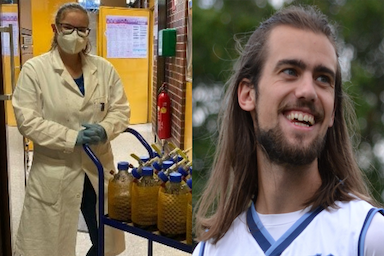Seminar of the Department of Microbiology
MSc Student Session 1
Katharina Nussbaumer - AG Insam - University of Innsbruck
Christoph Geyer - AG Illmer - University of Innsbruck
27.01.2022, 11:00 - Join online

Abstracts
Nussbaumer: Anaerobic co-digestion of sewage sludge and pure glycerol
My master thesis is embedded in the “2strategies4AD” project, which started in 2020 and which tries to evaluate two different strategies for improving the performance of biogas plants. The aim of the study is to investigate the effect of different glycerol concentrations on the anaerobic co-digestion of sewage sludge. Anaerobic digestion (AD) is a way to use sewage sludge or other organic residues to generate biogas. Biogas shows multiple environmental benefits such as the production of green energy or environmental protection (Mao et al., 2015). Many authors suggest anaerobic co-digestion as efficient strategy to improve biogas and methane yields (e.g. Fountoulakis, Petousi and Manios, 2010). Co-digestion typically involves the addition of a high-energy product such as food waste, fat or used oil (Aichinger, 2015). In this case, glycerol was used, which occurs in huge amounts as by-product of various technical processes such as the production of soap, bioethanol or biodiesel. Beside the high availability, it shows multiple advantages: high biodegradability and good handling properties due to its liquid nature (Jensen et al., 2014). Since crude glycerol typically contains a high percentage of impurities (Viana et al., 2012) (crude glycerol consists of 23 to 80% pure glycerol (dos Santos Ferreira, Volschan and Cammarota, 2018), we decided to use pure glycerol for this experiment to avoid potential disturbance or interference effects. We measured the biogas production and determined important physio-chemical parameters (pH, electrical conductivity, FOS/TAC, ammonium, phosphate, volatile fatty acids, chemical oxygen demand, total solids, volatile solids). In addition, we extracted DNA to perform 16S rRNA amplicon sequencing and proteins for metaproteome analysis. After gathering all data, we will perform a balancing of the wastewater treatment plant of Bolzano, which provided the fresh sewage sludge for the experiment. This shall help determining whether the addition of glycerol as co-substrate may be profitable for the facility.
Geyer: Lake Sediments – a strange microbial habitat
Although freshwater lakes are very well-studied, there are little data on respective sediment microbiology. Therefore, we started to take a closer look at this microbial habitat and investigated a sediment of the Millstätter See in cooperation with the Department of Geology. In addition to abiotic sediment parameters and microbial cultivation techniques, amplicon sequencing is performed with samples from different depths of the sediment core. By using geological methods different depths of the sediment core can be exactly dated, allowing an assignment of microbial data to the last 550 years. The presentation gives insight into the first results of my master thesis performed in the working of Paul Illmer.
